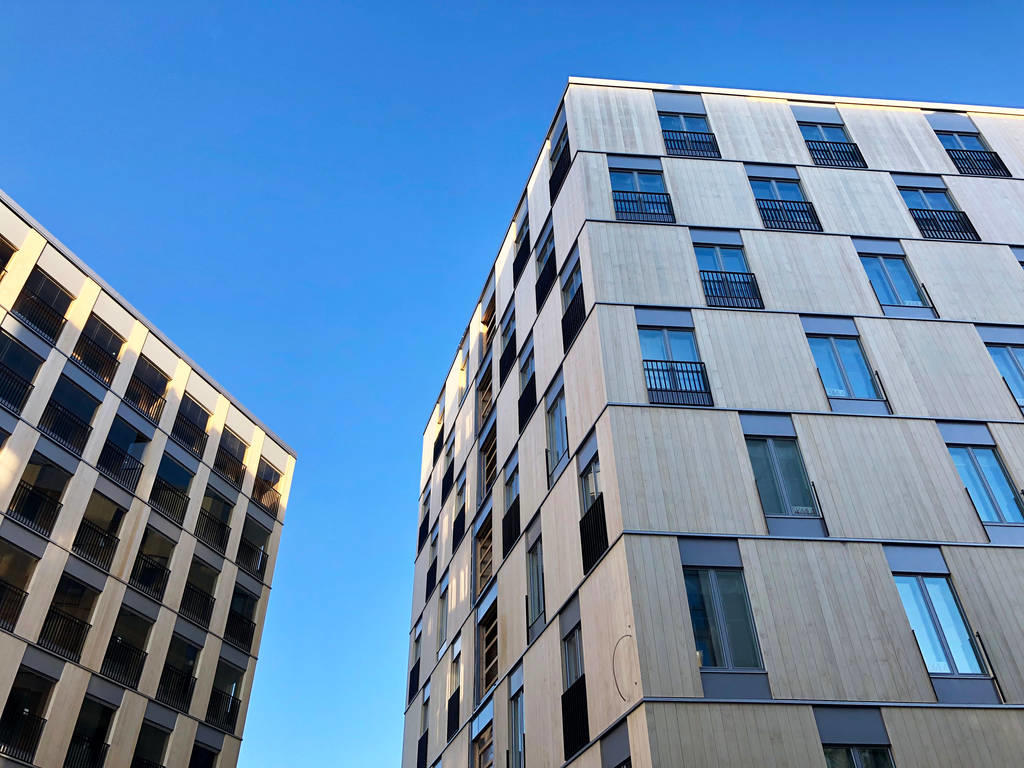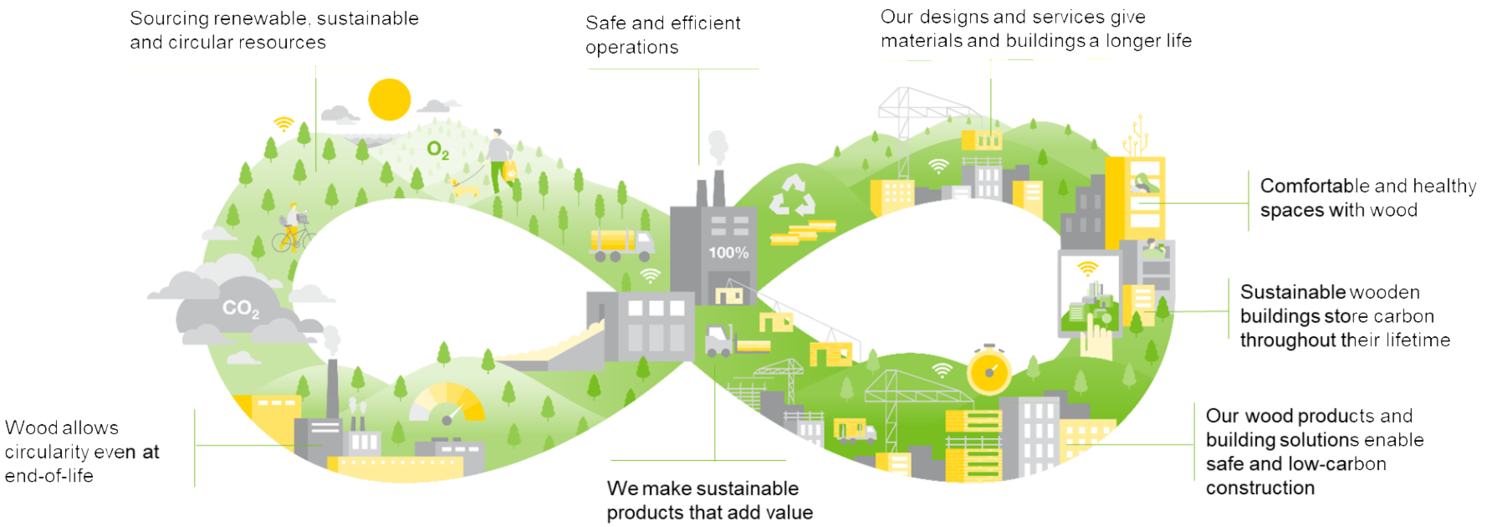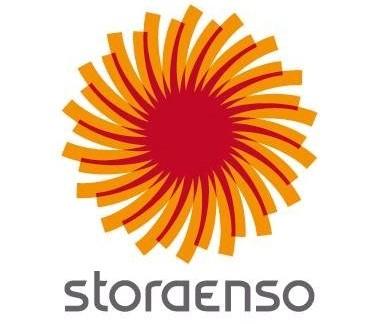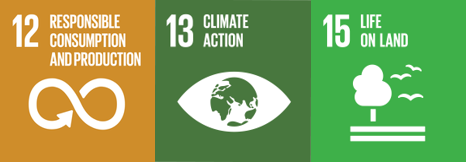Stora Enso: How wood can help build a sustainable future

Stora Enso develops and produces solutions based on wood and biomass for a range of industries and applications worldwide.
Building on its heritage and know-how in forestry and trees, Stora Enso is committed to the development of products and technologies based on renewable materials and creating value in a sustainable bio-economy, providing low-carbon alternatives to many products made from fossil-based or other non-renewable materials.
Stora Enso is the largest supplier of wooden construction material in Europe and the world’s fourth largest, with 21 production units in 11 different countries.
Stora Enso supports all seventeen Sustainable Development Goals (SDGs), and the Goals 12, 13 and 15 were identified as the most strategic to its business. Its approach towards addressing the SDGs is in line with the SDG Compass, which was developed by the Global Reporting Initiative (GRI), the UN Global Compact (UNGC), and WBCSD as a guide for companies.
Summary
Demand for building materials is rapidly growing, driven largely by urbanization and economic growth in emerging economies and the need to retrofit and renovate existing buildings in developed countries. Sustainable wood can meet this growing demand by substituting for existing building materials where possible. This can address climate change objectives by storing carbon in the building stock (beyond the forests) and through lower material manufacturing and processing emissions. To help reap these climate benefits and support the widespread adoption of sustainable buildings from engineered wood such as cross laminated timber (CLT) and laminated veneer lumber (LVL), Stora Enso develops open source “building concepts” (explained in manuals) that detail all phases from building design to maintenance for different types of buildings.
Stora Enso also helps to create so-called ecosystems where material providers, users, contractors and other value chain actors exchange their expertise and insight to improve the delivery process and the sustainability performance of a building.
Background
From a classic sawn producer to a leading provider of innovative wood-based solutions, Stora Enso aligned its strategy to respond to a range of ongoing mega-trends shaping the world and the way people consume. Population growth, urbanization, global warming and eco-awareness are notably driving the growth in demand for raw materials that are renewable, reusable and fossil-free. Sustainable forestry-based solutions are central to help meeting the growing demand for green building.
Initiative
Stora Enso’s building concepts promote wood construction and help combat global warming, by improving the carbon footprint of buildings and lowering material manufacturing and processing emissions.
Moving to composite, wood or bio‐based materials can help to reduce embodied carbon in buildings, and through carbon storage help achieve net-zero carbon buildings.
Nevertheless, barriers continue to hinder efforts to introduce and scale up the use of low carbon, renewable wood-based solutions for buildings. Stora Enso’s open source Building Concepts are developed to help overcome barriers and inspire customers and other value chain members to design, construct and maintain sustainable buildings from wood. Based on various building components and products like Cross-laminated timber (CLT) and Laminated veneer lumber (LVL), the building concepts are driven by a cost-competitive analysis done with customers and specifiers in key markets.
These concepts are further explained in manuals detailing all phases, from building design to maintenance. As of today, the focus is on six countries (Austria, Finland, France, Germany, Sweden and the United Kingdom), ensuring that the concepts include country-specific details in accordance with national regulations (e.g. fire safety, acoustic requirements, etc.). The first Building Concepts developed are for residential multi-story buildings, which cover construction with panels and modules. Stora Enso has also launched a concept for eco-schools and is developing a concept for commercial office buildings.
Stora Enso also aims to help customers make informed decisions by publishing information on the environmental life cycle impacts of its products through third party validated Environmental Product Declarations (EPDs). EPDs can be used by our customers to help optimize environmental performance using whole building life cycle assessments (LCAs) and to achieve green building certification.
Stora Enso furthermore promotes project delivery in so-called ecosystems, which bring together the various actors throughout the value chain, and can help improve the delivery process and sustainability performance of a building by incorporating expertise from actors such as users, material providers and contractors early in the process.
Key outcomes & lessons learned
By promoting open Building Concepts, Stora Enso aims to create a trusted and large ecosystem for massive wood construction that allows developers, investors and designers to specify, deliver and scale massive wood buildings. The first Building Concepts were developed for residential multi-story buildings, and have been applied in the Wood City project in Helsinki.
Stora Enso is increasingly involved in several projects showing how the use of wood products in construction can significantly reduce embodied carbon emissions through substitution and storage, contributing to SDG 13.
For example, in the UK, the Bridport House project (a multi-storey residential building using Stora Enso’s CLT materials) demonstrated that a CLT frame can save up to 75% of emissions from building materials used. In addition, a CLT frame stores carbon and can hereby significantly contribute to achieving net zero embodied emissions.
In addition, Stora Enso is the supplier of massive wood products to a residential project in Växjö municipality in southern Sweden. A total of 6,300 m3 of CLT (Cross Laminated Wood) is delivered to the Trummens Strand project, making this one of the largest wooden building projects in the Nordic countries to date. The project includes 150 exclusive apartments and a pre-school and is expected to store 1,200 tonnes of carbon.
Next steps
To build on the success of the first Building Concepts, Stora Enso will replicate this approach and launch Building Concepts for schools and commercial office buildings.
Additionally, to meet the continuously growing demand for sustainable building materials, Stora Enso is investing to develop new CLT production units and has started up CLT rib panel production in Austria. Rib panels offer an effective and cost competitive solution for construction projects that require long load bearing spans, such as commercial and industrial buildings and schools.
Finally, Stora Enso and TRÄ Group have signed a joint development agreement to improve the construction efficiency and increase the digitalization in the industry´s value chain with services for healthy and affordable living. The target is to make the design and specification of wooden buildings easier, attaining smarter manufacturing and construction.
More information
To learn more about Stora Enso's projects and initiatives for sustainable construction, please consult:
- Building concepts
- Going with the Grain: how wood can help us build a sustainable future
- Podcast: How are digital solutions making the construction industry more sustainable?
- Massive building applications:



